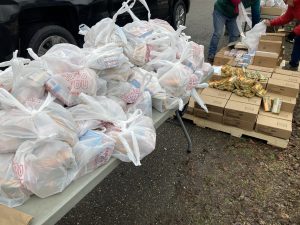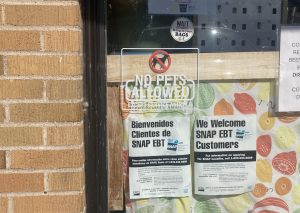News
Food banks and SNAP recipients express alarm at a possible funding reduction in the upcoming farm bill
By: Theo Peck-Suzuki | Report for America
Posted on:
ATHENS, Ohio (WOUB/Report for America) — Every month, Jody Dearth’s EBT card gets loaded up with the bare minimum of supplementary income to help cover the cost of groceries. This fiscal year, that’s $23.
“I’ve had people say, ‘Why do you even do the paperwork for it?’” Dearth said. “It’s milk and bread.”
That much money — less than a single night out at many restaurants — may seem negligible to some, but Dearth, a part-time service worker at O’Bleness Memorial Hospital, said it can make the difference between whether she has to skip meals that month or not.
“Because you have to pay your electric, your water. Insurance, definitely. You have to. You cannot let that stuff go,” she said.
The $23 comes from the Supplemental Nutrition Assistance Program, better known as SNAP. The program is funded through the federal farm bill, which Congress is supposed to pass every five years. The latest iteration of the bill is over a year late as various disagreements slow negotiations. SNAP is reportedly one of the main sticking points, with the House of Representatives’ draft bill proposing a change that would cut funding by $30 billion over 10 years, according to the Congressional Budget Office.
The way this cut would work, advocates acknowledge, is “wonkish.” It involves rolling back a similarly subtle but impactful change from the last farm bill in 2018: an update to the Thrifty Food Plan.
The Thrifty Food Plan is an estimate: How much money does a family need at minimum to afford a healthy meal? The USDA bases SNAP payments on that estimate.
Until the 2018 farm bill passed, the formula for calculating the Thrifty Food Plan was based on the cost of a meal from the 1970s, according to Ohio Association of Foodbanks Executive Director Joree Novotny. The USDA adjusted it over the years to keep up with overall inflation — but as it turns out, that led to something of a math error.
“The cost of food is much more volatile … than general cost of living,” Novotny explained.

This, along with a few other problems, meant the Thrifty Food Plan — and by extension SNAP — was far weaker than what families needed by 2018, Novotny said. Then Congress passed the 2018 farm bill and changed the formula to include all those other factors. The adjustments took effect in 2021 and led to an increase in baseline SNAP funding.
(This was separate from the emergency SNAP allotments Congress authorized during the pandemic, which expired in March 2023.)
Novotny said the current House version of the next farm bill does away with these updates to once again make SNAP “budget neutral.” That means it would once again just track inflation as a whole. As it turns out, that’s about $30 billion less for the program over 10 years.
Novotny said that change would reflect “a lack of living in reality about what our food supply chain looks like.”
What impacts could a SNAP cut have?
Novotny’s colleague Hope Lane-Gavin said making SNAP budget neutral may not be the cost-saving measure some envision.
“Food helps to either exacerbate or combat a lot of diet-related diseases in this country. We’re talking diabetes, we’re talking high cholesterol, we’re talking heart disease … The research continues to demonstrate that access to food and being food secure can either eliminate or better manage those diet-related diseases,” Lane-Gavin said.
Conversely, getting sick costs the government money through emergency room visits and bills to Medicare and Medicaid.
The problem, Lane-Gavin said, is that without SNAP, there isn’t really a good way for people on low incomes to get healthy food. The alternative is going to a food bank or pantry, but those don’t offer much in the way of choice. People can’t always get what the doctor recommends.
Ideally, Lane-Gavin said, SNAP would actually be getting a bigger boost — perhaps shifting from the Thrifty Food Plan to the slightly more generous Low-Cost Food Plan.
“We would like to get to a point in this country, and in food banking, where nutrition security is prioritized, and we need benefit adequacy to do that,” Lane-Gavin said.

“Because you can’t afford the healthy stuff,” she said. “You can’t afford organic, or all that kind of stuff. You just cannot. Because it’s way higher. Even the lettuce — you know, if you want to eat some lettuce, that’s so expensive. You just can’t buy that stuff at all.”
Novotny said the SNAP cut would force more people to go to food banks, which are already reeling from years of increasing demand — partly because of the pandemic and partly for other reasons.
“We saw more and more older adults every year — well before the pandemic ever struck — coming to our lines,” Novotny said. “They’re finding themselves reaching retirement age, unable to bring in … earnings to supplement whatever their modest retirement incomes look like.”
Bucky Hall said he was just entering recovery from drug addiction when prices started going up. The change, he said, was bewildering.
“When you go into drugs, it’s a whole different world, and then when you come back out to civilization, it’s — everything’s changed on you,” he said. “So as I come out of the drugs, I got back into work, and it’s like, not making enough money to survive.”
Hall and his wife, Christy, receive $495 in SNAP a month.
“In a family of three, that’s going to stretch, maybe, about two-and-a-half weeks,” he said.
To fill the gap, the Halls also visit the Athens County Food Pantry from time to time, and Hall uses 5 gallon buckets to grow his own vegetables in his apartment.
Eva Bloom of the Southeast Ohio Foodbank said food banks and pantries are already facing a supply shortage from their main federal support program, TEFAP, which also gets its money through the 2018 farm bill. She said that program needs about a 20% boost in funding to meet post-pandemic demand, but the House version of the new farm bill would only raise it 9%.
“They (the House) have a $40 million increase per year in food purchases, which isn’t really enough to get us where we need to go in terms of serving all of the demand that we have,” Bloom said.
Between TEFAP, the SNAP cut, and the potential loss of the Local Food Purchasing Assistance program, food banks could be looking at a serious squeeze on their inventories.
Dearth said for now, between SNAP and local food pantries, she and her husband can make things work. She’s not sure that would still be the case if either faced a cut.
“I feel like it would be bad if they cut it back,” she said.
Christy Hall grew emotional at the suggestion.
“I feel that families will not survive,” she said. “It’s wrong. It’s very wrong.”
The Senate has not yet passed a version of the farm bill out of committee, but Senate Agriculture Committee chairwoman Debbie Stabenow has signaled opposition to the House’s SNAP changes. With negotiations far from concluded, it remains to be seen what the final farm bill includes. Congressional leaders have said they hope to pass the farm bill in the lame-duck session after the November election.

